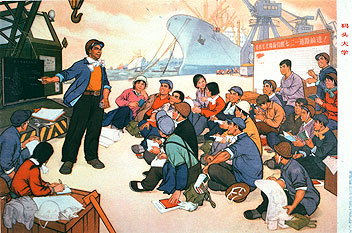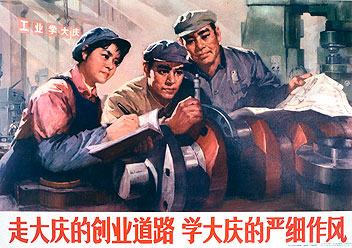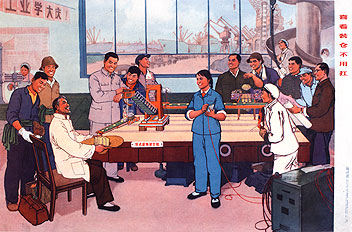Industrial development
During the 1950s China borrowed industrial models from the Soviet Union. Already at an early stage this often proved to be a mistake. China was still a developing country at a primitive stage of development with completely different conditions compared with those of USSR. Thus, China during a period of twenty years from 1958 and onwards attempted a number of novel approaches to speed up its industrial development.
Mass mobilization that had proven successful in construction works was during 1958-1960 applied in actual industrial production — The Great Leap Forward — but failed. However, Daqing remained a model widely used in Chinese propaganda for a number of years. This model was based on self-reliance, with a far-reaching involvement of all family members in industrial activities, and an almost complete political control of the industry itself. The attention to self-sufficiency in oil production required an almost military-command approach which did not fit most other industrial sectors — although widely used as a propaganda model.
Steel and Coal Production
Iron and steel production was given almost the same attention as petroleum production, although the sector was further along in its development. When modernization plans were announced in 1978 the expansion of steel plants were given special attention. An annual production goal of 65 million tons was announced for 1985. The existing iron and steel plant in Wuhan should substantially expand and new plants were to be built, with one of them to be located in Shanghai. Posters at the time suggested that with increased steel production the Chinese society would completely change. The cities would acquire a Manhattan skyline. That vision gradually changed and improved transportation and energy production were given more attention.
An earlier expansion of the coal industry, often utilizing small pits, and a diffusion of industrial knowledge throughout the country provided a basis for future industrialization. Despite all failings of the Cultural Revolution this period saw a rapid expansion of small-scale industries in rural areas. The lessening of central control during the period allowed people’s communes and rural towns to independently start industries. Today they play an important role in China’s further industrialization and are referred to as village and township enterprises (VTE). Many of them have been seeds for large enterprises that are also entering export markets. Many of them are being reorganized and require further changes, not at least for environmental reasons.
Productivity Development
China at the end of 1970s was still a developing country with an extremely low productivity compared with industrialized countries. The manufacture of a railway engine (locomotive) would have required 50 times more man-hours that a similar product from General Electric in the US. Low productivity was often combined with excessive use of raw material and more seriously poor quality where many companies were in need of substantial improvements. In September 1978 China announced a first quality month. Today China has radically transformed most of its industrial structure for which models are often borrowed from other countries.

Grasp Revolution to Promote Production – Fight for a Great Leap Forward in Steel (313-17-177)

The Harbour University (312-56-136)

Take the Daqing Road for Initiatives – Take the Daqing Spirit for Attention (311-66-66)

Packing without Load-carrying Brings Happiness (312-53-133)
